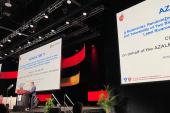Low Bleeding Risk With Abelacimab in AF Patients Undergoing Invasive Procedures
With the factor XI inhibitor, clinicians may have more flexibility when managing anticoagulation in this common scenario.

If the novel factor XI inhibitor abelacimab reaches the market for patients with atrial fibrillation (AF) who require anticoagulation, it may not be necessary to interrupt treatment ahead of invasive procedures, at least in cases deemed to carry a low risk for bleeding, an analysis of the AZALEA-TIMI 71 trial suggests.
Among the roughly one-third of patients who underwent a procedure during the trial, such as a colonoscopy, coronary angiography, or orthopedic surgery, there was a low rate of ISTH major/clinically relevant nonmajor bleeds within 30 days: 1.2% in the abelacimab arm and 2.2% in the rivaroxaban arm (risk ratio 0.54; 95% CI 0.19-1.58).
“You could imagine that if factor XI inhibition is really as safe as it seems to be, particularly with respect to bleeding around procedures, we could change the paradigm of how we manage anticoagulation without needing to interrupt, particularly for some of these lower-bleeding-risk procedures that end up actually being the most common in this patient population,” Siddharth Patel, MD (Brigham and Women’s Hospital, Boston, MA), lead author of the new analysis, told TCTMD.
About three-quarters of the procedures were elective, with a similar proportion considered to convey a low bleeding risk.
It remains standard practice to interrupt anticoagulation 1 to 2 days before most procedures for patients with AF, said Patel, but it’s not uncommon that patients forget to skip a dose before coming to the hospital, resulting in delayed procedures.
The results from this AZALEA-TIMI 71 subanalysis are “just some of the first preliminary results that we’re seeing with pharmacologic factor XI inhibition,” said Patel. “But I think if these results could be further confirmed across larger trials that are being done now with such long-acting factor XI inhibition, you could see a paradigm shift.”
The findings were published online ahead of the June 17, 2025, issue of the Journal of the American College of Cardiology.
Periprocedural Bleeding in AZALEA-TIMI 71
There are several factor XI inhibitors, either monoclonal antibodies like abelacimab (Anthos Therapeutics) or antisense oligonucleotides, under development and studies—including AZALEA-TIMI 71—have shown that they may provide a much lower risk for bleeding compared with warfarin or the direct oral anticoagulants (DOACs).
These agents also have much longer half-lives than do DOACs—ranging from weeks to months versus several hours. That means that interruption of anticoagulation with factor XI inhibitors prior to a procedure is “really not practical” in an elderly AF population with multiple comorbidities, Patel said.
“We really need to demonstrate that such long-acting anticoagulants can be safely used in patients who may frequently require procedures,” he said.
AZALEA-TIMI 71, a phase IIb study, compared the safety and tolerability of two abelacimab doses (90 and 150 mg administered subcutaneously monthly) versus rivaroxaban 20 mg once daily in patients with AF and a moderate-to-high risk for stroke. As reported previously, the factor XI inhibitor reduced major or clinically relevant nonmajor bleeding compared with the DOAC.
Abelacimab has a half-life of about 28 days, meaning that residual drug activity is expected to last beyond the monthly dosing interval. Due to the lack of relevant RCT data, periprocedural management of abelacimab in AZALEA-TIMI 71 was based on recommendations for patients with congenital factor XI deficiency.
Interruption of treatment and use of adjunctive therapies to reduce bleeding were not required for low-bleeding-risk procedures, whereas “sites were encouraged to consider the use of an antifibrinolytic agent (such as tranexamic acid) as prophylaxis to minimize bleeding, without necessitating interruption of abelacimab” for intermediate- or high-risk procedures, the investigators note. For certain very high-risk procedures like spinal surgery or open thoracic or abdominal surgery, operators were encouraged to interrupt abelacimab for at least 30 days and consider using an antifibrinolytic agent and low-dose recombinant factor VIIa if interruption wasn’t possible.
In the rivaroxaban arm, investigators were advised to follow standard of care, which involves stopping treatment 1 to 2 days before most procedures.
As part of AZALEA-TIMI 71, 441 patients (median age 74 years, 63.3% men) underwent an invasive procedure during a median follow-up of 2.1 years. The median time from the last dose of abelacimab to the procedure was 29 days, with 55.8% of procedures occurring within the monthly dosing interval.
Periprocedural bleeding—ISTH major/clinically relevant nonmajor bleeds occurring within 30 days and deemed related to the procedure on blinded review—occurred in less than 2% of procedures overall, with a tendency for fewer in the abelacimab arm. There were no fatal bleeds.
And among 336 procedures that occurred within 30 days of the last abelacimab dose—meaning that there would still be residual drug activity—there were only three periprocedural bleeds (0.9%).
Unanswered Questions
Any discussions about the impact of factor XI inhibitors are predicated on whether these drugs will eventually be approved, according to James Douketis, MD (McMaster University, Hamilton, Canada), lead author of an accompanying editorial in JACC. Despite some missteps—including the early stoppage of OCEANIC-AF, a trial of the factor XIa inhibitor asundexian, due to inferior efficacy versus apixaban—at least some of these medications will likely make it into clinical practice, he predicted.
“Patients who are anticoagulated frequently require procedures or surgeries and it will become something that clinicians will need to deal with,” Douketis told TCTMD. “When I say that, I mean a wide array of clinicians, ranging from dentists to neurosurgeons.”
With long-acting agents like abelacimab, it’s not feasible to interrupt treatment, he said. “If we can show that you don’t really need to worry about that, you can go ahead and have your procedure or surgery. It will make things a lot easier for all the clinicians involved in the procedure, whether it’s the surgeon, the proceduralist, the anesthesiologist, the hematologist, or the cardiologist that’s handling these drugs.”
Despite the rigorous design for the current analysis, there are some limitations, Douketis indicated, pointing to the small number of patients who had major surgeries carrying a high risk for bleeding. Those “are the patients that really we need to focus on,” he said. “This study wasn’t designed to do that, but it’s something that will need to be addressed in future studies.”
For now, “these drugs don’t appear to really increase bleeding risk, and even with the stress test of surgery or a procedure, bleeding is less while there’s an ongoing effect as compared to bleeding in the DOAC group, where the drug was stopped and resumed,” Douketis said.
That leaves the question of efficacy in terms of preventing stroke, an issue that AZALEA-TIMI 71 was not designed to address either, he added.
Larger studies are underway, Patel noted, citing the LILAC-TIMI 76 trial of high-risk patients with AF who have been deemed unsuitable for oral anticoagulation. “I think further procedural data, particularly from larger studies where we have a higher number of nonelective as well as high-bleeding-risk procedures, will be important,” he said.
Todd Neale is the Associate News Editor for TCTMD and a Senior Medical Journalist. He got his start in journalism at …
Read Full BioSources
Patel SM, Giugliano RP, Morrow DA, et al. Long-acting factor XI inhibition and periprocedural bleeding: an analysis from AZALEA-TIMI 71. JACC. 2025;85:2288-2298.
Douketis JD, Steg G, Cannegieter SC, Spyropoulos AC. Perioperative management of patients taking factor XI inhibitors: small steps toward a giant leap. JACC. 2025;85:2299-2301.
Disclosures
- AZALEA-TIMI 71 was funded by Anthos.
- Patel reports being supported by a K12TR004381 award through Harvard Catalyst, The Harvard Clinical and Translational Science Center (National Center for Advancing Translational Sciences, National Institutes of Health), and having receiving consultant/advisory fees from Janssen. He is a member of the TIMI Study Group, which has received institutional research grant support through Brigham and Women’s Hospital from Abbott, Abiomed, Amgen, Anthos Therapeutics, ARCA Biopharma, AstraZeneca, Boehringer Ingelheim, Daiichi Sankyo, Ionis Pharmaceuticals, Janssen Research and Development, MedImmune, Merck, Novartis, Pfizer, Regeneron Pharmaceuticals, Roche, Saghmos Therapeutics, Siemens Healthcare Diagnostics, Softcell Medical Limited, The Medicines Company, Verve Therapeutics, and Zora Biosciences.
- Douketis reports no relevant conflicts of interest.





Comments